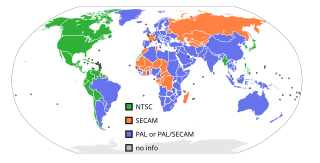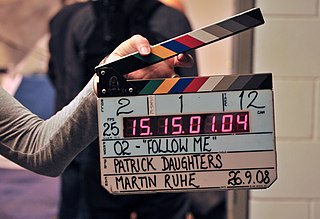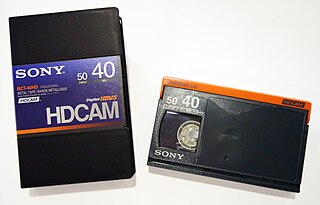MIDI time code (MTC) embeds the same timing information as standard SMPTE timecode as a series of small 'quarter-frame' MIDI messages. There is no provision for the user bits in the standard MIDI time code messages, and SysEx messages are used to carry this information instead. The quarter-frame messages are transmitted in a sequence of eight messages, thus a complete timecode value is specified every two frames. If the MIDI data stream is running close to capacity, the MTC data may arrive a little behind schedule which has the effect of introducing a small amount of jitter. In order to avoid this it is ideal to use a completely separate MIDI port for MTC data. Larger full-frame messages, which encapsulate a frame worth of timecode in a single message, are used to locate to a time while timecode is not running.

NTSC is the first American standard for analog television, published and adopted in 1941. In 1961, it was assigned the designation System M. It is also known as EIA standard 170.

Vertical Interval Timecode is a form of SMPTE timecode encoded on one scan line in a video signal. These lines are typically inserted into the vertical blanking interval of the video signal.
Differential Manchester encoding (DM) is a line code in digital frequency modulation in which data and clock signals are combined to form a single two-level self-synchronizing data stream. Each data bit is encoded by a presence or absence of signal level transition in the middle of the bit period, followed by the mandatory level transition at the beginning. The code is insensitive to an inversion of polarity. In various specific applications, this method is also called by various other names, including biphase mark code (CC), F2F, Aiken biphase, and conditioned diphase.
A timecode is a sequence of numeric codes generated at regular intervals by a timing synchronization system. Timecode is used in video production, show control and other applications which require temporal coordination or logging of recording or actions.

SMPTE timecode is a set of cooperating standards to label individual frames of video or film with a timecode. The system is defined by the Society of Motion Picture and Television Engineers in the SMPTE 12M specification. SMPTE revised the standard in 2008, turning it into a two-part document: SMPTE 12M-1 and SMPTE 12M-2, including new explanations and clarifications.
AES3 is a standard for the exchange of digital audio signals between professional audio devices. An AES3 signal can carry two channels of pulse-code-modulated digital audio over several transmission media including balanced lines, unbalanced lines, and optical fiber.

A clapperboard, also known as a dumb slate, clapboard, film clapper, film slate, movie slate, or production slate, is a device used in filmmaking, television production and video production to assist in synchronizing of picture and sound, and to designate and mark the various scenes and takes as they are filmed and audio-recorded. It is operated by the clapper loader. It is said to have been invented by Australian filmmaker F. W. Thring. Due to its ubiquity on film sets, the clapperboard is frequently featured in behind-the-scenes footage and films about filmmaking, and has become an enduring symbol of the film industry as a whole.

Serial digital interface (SDI) is a family of digital video interfaces first standardized by SMPTE in 1989. For example, ITU-R BT.656 and SMPTE 259M define digital video interfaces used for broadcast-grade video. A related standard, known as high-definition serial digital interface (HD-SDI), is standardized in SMPTE 292M; this provides a nominal data rate of 1.485 Gbit/s.
Inter-range instrumentation group timecodes, commonly known as IRIG timecode, are standard formats for transferring timing information. Atomic frequency standards and GPS receivers designed for precision timing are often equipped with an IRIG output. The standards were created by the Tele Communications Working Group of the U.S. military's Inter-Range Instrumentation Group (IRIG), the standards body of the Range Commanders Council. Work on these standards started in October 1956, and the original standards were accepted in 1960.

HDCAM is a high-definition video digital recording videocassette version of Digital Betacam introduced in 1997 that uses an 8-bit discrete cosine transform (DCT) compressed 3:1:1 recording, in 1080i-compatible down-sampled resolution of 1440×1080, and adding 24p and 23.976 progressive segmented frame (PsF) modes to later models. The HDCAM codec uses rectangular pixels and as such the recorded 1440×1080 content is upsampled to 1920×1080 on playback. The recorded video bit rate is 144 Mbit/s. Audio is also similar, with four channels of AES3 20-bit, 48 kHz digital audio. Like Betacam, HDCAM tapes were produced in small and large cassette sizes; the small cassette uses the same form factor as the original Betamax. The main competitor to HDCAM was the DVCPRO HD format offered by Panasonic, which uses a similar compression scheme and bit rates ranging from 40 Mbit/s to 100 Mbit/s depending on frame rate.
Time base correction (TBC) is a technique to reduce or eliminate errors caused by mechanical instability present in analog recordings on mechanical media. Without time base correction, a signal from a videotape recorder (VTR) or videocassette recorder (VCR), cannot be mixed with other, more time-stable devices such as character generators and video cameras found in television studios and post-production facilities.
SMPTE 292 is a digital video transmission line standard published by the Society of Motion Picture and Television Engineers (SMPTE). This technical standard is usually referred to as HD-SDI; it is part of a family of standards that define a serial digital interface based on a coaxial cable, intended to be used for transport of uncompressed digital video and audio in a television studio environment.
Control track longitudinal timecode, or CTL timecode, developed by JVC in the early 1990s, is a unique technique for embedding, or striping, reference SMPTE timecode onto a videotape.
A Multichannel Audio Serial Port (McASP) is a communication peripheral in digital signal processor (DSP) and microcontroller unit (MCU) components from Texas Instruments.
The Rewriteable Consumer Timecode is a nearly frame accurate timecode method developed by Sony for 8mm and Hi8 analog tape formats. The RC timecode tags each frame with the hour, minute, second and frame for each frame of video recorded to tape. Officially, RCTC is accurate to within ±2 to 5 frames. The RC timecode can be used in conjunction with the datacode to record the date and the time. The data and RC codes are written between the video and the PCM audio tracks. It may be added to any 8-mm tape without altering the information already on the tape, and is invisible to machines not equipped to read it.
The ADAT Lightpipe, officially the ADAT Optical Interface, is a standard for the transfer of digital audio between equipment. It was originally developed by Alesis but has since become widely accepted, with many third party hardware manufacturers including Lightpipe interfaces on their equipment. The protocol has become so popular that the term ADAT is now often used to refer to the transfer standard rather than to the Alesis Digital Audio Tape itself.
Audio-to-video synchronization refers to the relative timing of audio (sound) and video (image) parts during creation, post-production (mixing), transmission, reception and play-back processing. AV synchronization can be an issue in television, videoconferencing, or film.
In video engineering, color framing refers to the color frame sequence of fields in a composite video signal through which the video frame timing and chrominance subcarrier signal timing—in particular, that of the color burst -- cycle through all possible phase relationships.

D6 HDTV VTR is SMPTE videocassette standard. A D6 VTR can record and playback HDTV video uncompressed. The only D6 VTR product is the Philips, now Thomson's Grass Valley's Media Recorder, model DCR 6024, also called the D6 Voodoo VTR. The VTR was a joint project between Philips Digital Video Systems of Germany and Toshiba in Japan. The tape deck module was designed and made by Philips in Weiterstadt, Germany, and the digital processor module designed and made by Toshiba. Since there is no data compression, after 20 tape copies of multi generations there is no noticeable loss of quality. As a very high-end, costly system about 70 were sold to high-end post houses from about 2000 to 2005. The VTR had a data record option. The data module could record and play back 2k DPX files at 6 frames per second over a HIPPI connection. The VTR came in a data only model, or with a switch module, so the record deck could be used for both video and data recording. The tape deck was also sold stand alone as a giga bit recorder to record and playback raw data. Toshiba made the video tape for the VTR. The high price of the video tape limited the use of the VTR.







